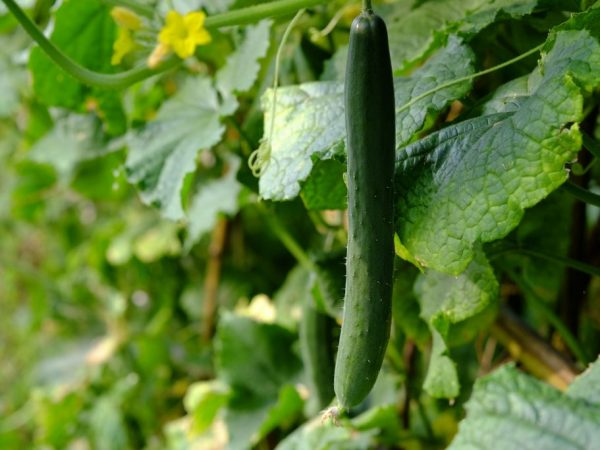Characteristics of the Chinese cold hardy cucumber
Chinese salad varieties of cucumbers are a godsend for both farms and summer cottages. Let's consider what characteristics the Chinese cold-resistant cucumber has.

Characteristics of the Chinese cold hardy cucumber
Characteristics of the variety
The length of the fruits of Chinese cold-resistant cucumbers is 40-60 cm, sometimes 80 cm. The taste is pleasant, sweetish. The pulp is juicy and crispy. The skin is green, thin, becomes denser and thicker over time. Cucumbers are finely ribbed, with medium-sized white thorns. When overgrowing, the peel does not turn yellow, the seed cavity decreases, the seeds increase in size.
The harvest of Chinese cold-resistant cucumbers can be used not only fresh, but also in blanks.
Plants do not suffer from downy mildew, fusarium and gray rot.
The seeds are small. Fruiting is abundant and long.
Advantages of the variety
The positive features of the variety include:
- early maturity (50-55 days from the beginning of germination),
- high yield (30 kg per bush),
- shade tolerance,
- resistance to temperature extremes,
- cold resistance,
- excellent taste,
- disease resistance,
- the minimum number of side shoots,
- self-pollination.
Disadvantages of the variety
Among the disadvantages of the Chinese cold-resistant cucumber are:
- poor keeping quality, which means a short implementation period,
- lack of variety traits in the seeds of the next generation of F1 hybrids,
- too large and often crooked fruits.
- high lashes (from 150 to 350 cm),
- defeat by spider mites during the hot period.
Growing conditions

The plant needs a binding garter
When cultivating cold-resistant Chinese cucumbers, a garter to the support is necessary, otherwise you can lose the crop. Thin-skinned fruits lying on the ground easily rot.
The culture is grown both in the greenhouse and in the open field. Planting scheme - 3-4 seedlings per 1 sq. m.When a multi-row planting, there should be 25 cm between the plants, and 90 cm between the rows.
To ensure a good harvest, you need abundant timely watering and feeding. In case of a lack of moisture or essential elements (potassium, nitrogen or calcium), the fruits are deformed, acquiring a curved or twisted shape.
Seedling method of growing
For growing seedlings, a mixture of sod land and perlite is prepared, which provides moisture capacity and air permeability. The seeds are planted in tall cups to a depth of 1.5-2 cm and placed in a dark, warm place for 3-5 days. After emergence, the seedlings are transferred to the light. The optimum temperature for leaf development is 20-22 ° C. Higher temperatures lead to infection of tender seedlings with spider mites. Additional lighting prevents premature stretching of internodes.
Seedlings are planted in a permanent place at the age of 20-25 days in the presence of 9 true leaves, when the threat of recurrent frosts has passed. Planting holes are prepared with a diameter of up to 10 cm.Seedlings are removed from seedling containers along with an earthen clod, taking care not to damage the roots. So that the lump does not crumble during transplantation, the seedlings are watered 2-3 days before. The seedlings are carefully lowered into the holes and compact the earth around the roots so that no voids remain. The filled row is watered abundantly.
Sowing seeds under a film in a greenhouse increases the yield by an order of magnitude in comparison with open ground. However, when grown in this way, there is always a percentage of seeds that have not emerged.
Sowing in open ground
Sowing under the film is carried out in May on pre-heated raised ridges. A week before this, the beds are covered with black covering material so that the soil thaws and warms up to the desired depth.
The potting mix should be loose and nutritious. For oxygen enrichment, surface loosening of the soil is recommended after each watering. To retain moisture and reduce the number of weeds, it is advisable to mulch the soil at the planting sites.
Conclusion
Cucumbers Chinese cold-resistant F1 give a high yield in May, even from several seedlings. Crispy, juicy, fragrant, fresh cucumbers directly from the garden will provide gardeners with the necessary vitamins and minerals from spring to autumn.

